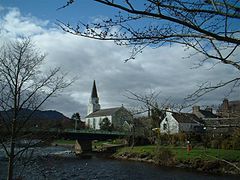Comrie
Comrie
|
|
|---|---|
 Comrie |
|
| Comrie shown within Perth and Kinross | |
| Population |
1,839 (2001 census) |
| OS grid reference | NN773219GB |
| Council area | |
| Lieutenancy area | |
| Country | Scotland |
| Sovereign state | United Kingdom |
| Post town | Crieff |
| Postcode district | PH6 |
| Dialling code | 01764 |
| Police | Scottish |
| Fire | Scottish |
| Ambulance | Scottish |
| EU Parliament | Scotland |
| UK Parliament | |
| Scottish Parliament | |
| Website | /www.comrie.org.uk |
1,839 (2001 census)
Comrie(/ˈkʌmri/;Gaelic: Cuimridh; Pictish: Aberlednock; Roman: Victoria) is an affluent village and parish in the southern highlands of Scotland, towards the western end of the Strathearn district of Perth and Kinross, 7 miles (11 km) west of Crieff. Comrie is a historic conservation village, recognised for its outstanding beauty (for which it has received many awards) and history and is also situated in a National Scenic Area around the river Earn. In addition Comrie is a thriving local community with over 50 local groups covering all ages and many interests. Situated on the Highland Boundary Fault, the village experiences more earth tremors than anywhere else in Britain. The town is twinned with Carleton Place, Ontario, Canada.
Comrie sits within the registration county of Perthshire (Gaelic: Siorrachd Pheairt) and the Perth and Kinross local council area. The name Comrie is derived from the original Gaelic name con-ruith or comh-ruith (from con/comh 'together', and ruith 'to run', 'running') translating literally as 'running together', but more accurately as 'together flowing' or 'the place where rivers meet'. In modern Gaelic the name is more often transcribed as 'Comraidh', 'Cuimridh' or 'Cuimrigh'. This is an apt toponym as the village sits at the confluence of three rivers. The River Ruchill (Gaelic: An Ruadh Thuill, The Red Flood) and The River Lednock (Scots Gaelic: An Leathad Cnoc, The Wooded Knoll) are both tributaries of the Earn (Gaelic: Uisge Dubh-Èireann) at Comrie, which itself eventually feeds into the Tay (Gaelic: Uisge Tatha).
...
Wikipedia

